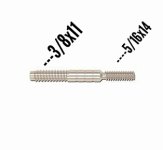You are using an out of date browser. It may not display this or other websites correctly.
You should upgrade or use an alternative browser.
You should upgrade or use an alternative browser.
Change butt pin 3/8-10 to 5/16-18
- Thread starter Floyd_M
- Start date
DeeDeeCues
Well-known member
Weak spot at the shoulder on 5/16 pin?
A dozen cue mfg's use 5/16x? and never have issues. Or am I missing something?
I haven't changed it yet...curious.
Stress risers occur at abrupt changes in geometry. In this case, if we consider the a simple 3/8"rod with one end turned down to 5/16", the rod will be weakest at the diameter change, and will be weaker than a solid 5/16" rod. Adding a radius to the transition can reduce or eliminate stress risers.
This is only an example. For the two different size screws to exist safely in one screw. A solid shoulder is added to the middle. This example already exist but it doesn't in the threads you need.Weak spot at the shoulder on 5/16 pin?
A dozen cue mfg's use 5/16x? and never have issues. Or am I missing something?
I haven't changed it yet...curious.
Hope this helps.
Attachments
Last edited:
I know about shoulders & radius's are for & the reasons. I've designed and made some tooling in my machinist days.
This pin in any configuration for this application, is strictly in tension, there's no side, shear or compression forces going on.
I'm done with this thread.
Thank you.
.
This pin in any configuration for this application, is strictly in tension, there's no side, shear or compression forces going on.
I'm done with this thread.
Thank you.
.
I know about shoulders & radius's are for & the reasons. I've designed and made some tooling in my machinist days.
This pin in any configuration for this application, is strictly in tension, there's no side, shear or compression forces going on.
I'm done with this thread.
Thank you.
.
I seriously doubt it would be an issue but I do like to look at all possibilities - what if the cue is dropped, that side load could affect it.
You're welcome
DeeDeeCues
Well-known member
I know about shoulders & radius's are for & the reasons. I've designed and made some tooling in my machinist days.
This pin in any configuration for this application, is strictly in tension, there's no side, shear or compression forces going on.
I'm done with this thread.
Thank you.
.
The stress risers still affect strength in tension.
Worrying about them in a pin for a cue is energy well wasted.
I agree, think about all possibilities.I seriously doubt it would be an issue but I do like to look at all possibilities - what if the cue is dropped, that side load could affect it.
You're welcome
Well, the pin will bend long before it breaks. That's the nature of Stainless Steel, it's not tempered.
But if one wants to whack their cue over the edge of a picnic table, it'll take at least 3 whacks to shatter the joint... but the pin survived.
I know, got fed-up with a 5/16-18 chinese import, but the pin survived. 3 years later I inserted it in another butt & still going strong.
OK FOLKS... I pulled the 3/8-10 pin out. YUP, took a little heat from a heat gun.
That pin was threaded in just 10 turns. Measured the holes depth, it was 1.25'' deep.
Well the 5/16-18 S.S. pins I have are 3.250'' long. Drilled that hole deeper.
Hand filed that pin for thread cutting and 10 minutes later (inc. 2 clean outs) it bottomed out.
Stuck a shaft on it and HOO-AHH, it's perfect. I'll glue it in later.
Tomorrow I'll test all my spare shafts and find one that the butt wants to marry.
.
That pin was threaded in just 10 turns. Measured the holes depth, it was 1.25'' deep.
Well the 5/16-18 S.S. pins I have are 3.250'' long. Drilled that hole deeper.
Hand filed that pin for thread cutting and 10 minutes later (inc. 2 clean outs) it bottomed out.
Stuck a shaft on it and HOO-AHH, it's perfect. I'll glue it in later.
Tomorrow I'll test all my spare shafts and find one that the butt wants to marry.
.
